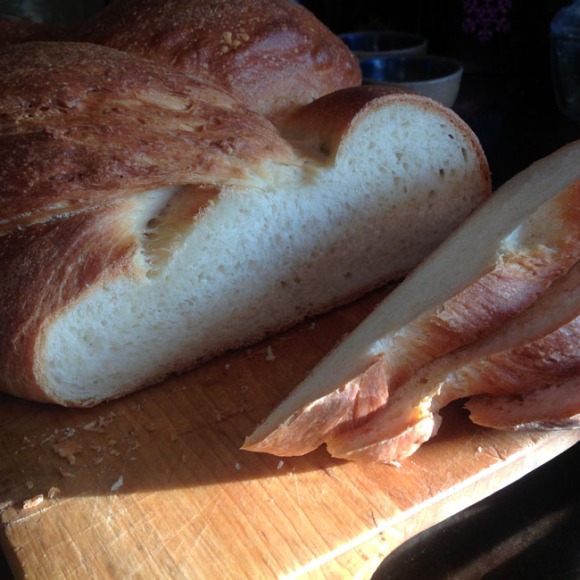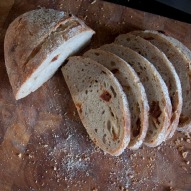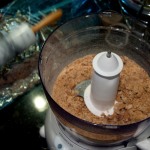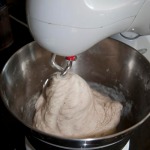It’s difficult to believe that it’s over three years since sourdough baking became a regular part of our life and our diet, back in May 2012. I predicted at the time that life would never be quite the same again and, in a variety of small ways, that’s definitely true. A lot has changed in our lives since then, but home baking has remained a constant despite upheavals and long working hours. We make a mix of sourdough and traditionally-yeasted breads at home, and they’re all wonderful in their own ways; the bar is set very high for bought breads and when time precludes home-baking, we’re inevitably disappointed by what we can buy in the shops.

Bread can seem like such a small, inconsequential thing, a cheap commodity which requires very little consideration. But good bread – really good bread – is a thing of great joy, not an afterthought but the crowning glory of a meal, or even a meal in itself. Still warm from the oven, with wonderful cornish unsalted butter melting into the crumb, I wonder if there is any more satisfying food in the world?
My wholemeal sourdough starter, ‘Seymore’, continues to thrive, and in some sense procreated last year when I started the process of converting a batch of starter to white flour. Each white flour feed progressively shifted the proportions and the starter is now 100% white. I find the white starter raises white loaves quite a bit more effectively than the wholemeal one did (presumably because the balance of microbes within it is already adapted to using white flour as a food source), so now like raises like – Seymore has an outing when I’m baking wholemeal or spelt, and the new white starter makes a quite wonderful, airy and chewy 100% white sourdough loaf.
A year or more ago, I had a hankering for home-made baguette. Initial experiments and trials with recipes in my cookbook library were all rather disappointing – they produced baguette-shaped loaves, but lacked not just the flavour, but also the crumb and the chewy, toothsome, slightly elastic crust of a genuine French loaf. French cookbooks, of course, were no use whatsoever – no French housewife in her right mind bakes her own bread, when there’s still a traditional ‘boulangerie’ in almost every village and on almost every street corner.
So I kept reading, and asking questions, and stumbled upon Paul Hollywood’s recipe from his pre-TV ‘100 Great Breads’ book, which begins with an overnight sponge, much like my everyday sourdough loaf. A bake through of his recipe produced one of the worst-behaved doughs I have ever worked with, but also gave me the best results to date. But it was still most definitely lacking ‘something’ in the flavour and texture departments. The sponge step, though, gave me an idea – what if I incorporated some of my white sourdough starter into the mix? Might that add, not just the complex savoury flavour that was lacking, but also the chewy elasticity to the crust? I had to experiment.
A year of trials later, I have a process that, while it’s not a ‘novice bake’, works very well and reliably for me, and as a bonus, can even be baked the same day you start if you forget to start the sponge the night before baking. It’s a ‘hybrid’ bread, making use of both the sourdough starter and of bakers’ yeast (much as many commercial loaves labelled as ‘sourdough’ do!). And while the results can sometimes look a little ‘wobbly’ and rustic, they have every bit of the flavour and characteristics of the loaves I enjoyed for my breakfast on a visit to Paris back in March. Torn in half, with unsalted butter and jam and a big mug of coffee, I challenge you to find a better everyday breakfast.
Of course, you can bake these loaves without the sourdough starter – you’ll be baking something like Paul Hollywood’s original recipe, and it’s not bad, but it’s just not the same!
To make these semi-sourdough baguettes, you will require –
 200g of 100% hydration white sourdough starter (that is, made up of 100g of flour and 100g of water), which has been ‘fed’ within the last 24hours. You’ll need to adjust the quantities of ingredients if your starter is balanced differently.
200g of 100% hydration white sourdough starter (that is, made up of 100g of flour and 100g of water), which has been ‘fed’ within the last 24hours. You’ll need to adjust the quantities of ingredients if your starter is balanced differently.- 400g of French bread flour (you can use British-style strong white bread flour, but the texture and flavour aren’t quite right; you’re going to a fair bit of trouble for these loaves, so it’s worth tracking down the good stuff!)
- 200ml of water at room temperature (or gently lukewarm on a cold day or when short of time)
- 1tsp or a 7g sachet of dried instant yeast
- 1tsp salt (this is my personal preference – recipes often double this quantity)
- 50g of softened unsalted butter
- Oil for kneading, and
- Semolina for dusting the baking sheet
 Ideally the night before, combine the 200g of starter with 100g of flour and 200ml of water, add the spoonful of instant yeast, and combine to create a thin batter. A whisk can be helpful. Cover with cling-film and set aside overnight, or, if you’re not that organised, for at least an hour and more if possible.
Ideally the night before, combine the 200g of starter with 100g of flour and 200ml of water, add the spoonful of instant yeast, and combine to create a thin batter. A whisk can be helpful. Cover with cling-film and set aside overnight, or, if you’re not that organised, for at least an hour and more if possible.
 The loaves will work fine with the shorter resting period but you’re inevitably sacrificing some flavour from the longer, slower fermentation. After resting, there should be some bubbles rising to the surface of your batter (more if you’ve left it overnight).
The loaves will work fine with the shorter resting period but you’re inevitably sacrificing some flavour from the longer, slower fermentation. After resting, there should be some bubbles rising to the surface of your batter (more if you’ve left it overnight).
 Now add the remaining 300g of flour, the salt and the softened (melted is fine) butter, and combine to make what will be a very soft, wet dough. Before kneading, just let it sit in the bowl for about half an hour to allow the flour grains to absorb as much as possible of the moisture and help the gluten start to set up.
Now add the remaining 300g of flour, the salt and the softened (melted is fine) butter, and combine to make what will be a very soft, wet dough. Before kneading, just let it sit in the bowl for about half an hour to allow the flour grains to absorb as much as possible of the moisture and help the gluten start to set up.
 Tip the dough onto a well oiled worktop, scraping out any that sticks to the bowl, and knead it for at least 10 minutes. It will be very sticky to start with, but this will improve to some extent with working. Try to resist adding extra flour unless absolutely essential, and if you do, add a very little at a time. This is never going to be an easy dough to work, you’re aiming to get it just on the right side of ‘impossible’. Working it with plenty of oil will reduce its tendency to stick to things other than itself, and avoids changing the hydration with flour from surfaces being incorporated into the dough.
Tip the dough onto a well oiled worktop, scraping out any that sticks to the bowl, and knead it for at least 10 minutes. It will be very sticky to start with, but this will improve to some extent with working. Try to resist adding extra flour unless absolutely essential, and if you do, add a very little at a time. This is never going to be an easy dough to work, you’re aiming to get it just on the right side of ‘impossible’. Working it with plenty of oil will reduce its tendency to stick to things other than itself, and avoids changing the hydration with flour from surfaces being incorporated into the dough.
 Once the dough is well kneaded, form a ball and set aside in a well oiled bowl, loosely covered with plastic or a tea towel to retain moisture, until it has at least doubled in size.
Once the dough is well kneaded, form a ball and set aside in a well oiled bowl, loosely covered with plastic or a tea towel to retain moisture, until it has at least doubled in size.
 Now, turn the dough out onto a well-oiled worktop and divide it into three as evenly as you can, but without faffing about (no grabbing a bit from here and sticking it onto there). You’ll see recipes instructing you to ‘roll the dough out into a baguette shape’, but don’t, ok? What you’ll get it you do that is a stodgy, even-textured dough shaped like a baguette (much as you get from most UK supermarkets, sadly). If you want the stretched curst and almost concentric-structured crumb of a genuine baguette, you need to form the shape properly. I got the clue I needed, oddly, from a TV travel show about Paris, where they popped into a boulangerie, and there in the background, when I paused and re-wound the programme, was a guy making baguettes. This way is rather fiddly, but it works!
Now, turn the dough out onto a well-oiled worktop and divide it into three as evenly as you can, but without faffing about (no grabbing a bit from here and sticking it onto there). You’ll see recipes instructing you to ‘roll the dough out into a baguette shape’, but don’t, ok? What you’ll get it you do that is a stodgy, even-textured dough shaped like a baguette (much as you get from most UK supermarkets, sadly). If you want the stretched curst and almost concentric-structured crumb of a genuine baguette, you need to form the shape properly. I got the clue I needed, oddly, from a TV travel show about Paris, where they popped into a boulangerie, and there in the background, when I paused and re-wound the programme, was a guy making baguettes. This way is rather fiddly, but it works!
First, find your widest, shallowest-sided baking sheet, and dust it generously with semolina. This will stop the dough sticking, and provides the characteristic ‘crunch’ to the base.
 Take each piece of dough, and fold two edges towards the centre. Without turning the dough, do this again and again in the same direction until you have quite a tight ‘cylinder’ with a centre seam on top, which will be about a third or half the length it needs to be. Now stretch out the cylinder lengthwise, gently, trying to keep the diameter even all the way along. Turn the baguette over so that it’s seam-side down, and tidy in the ends by tucking under into the traditional point if you can, though don’t worry if the ends are a bit dumpy. Tuck the sides under along the length of the loaf using a dough scraper, if you have one, and then, quickly so that it doesn’t sag, transfer the loaf to the baking sheet.
Take each piece of dough, and fold two edges towards the centre. Without turning the dough, do this again and again in the same direction until you have quite a tight ‘cylinder’ with a centre seam on top, which will be about a third or half the length it needs to be. Now stretch out the cylinder lengthwise, gently, trying to keep the diameter even all the way along. Turn the baguette over so that it’s seam-side down, and tidy in the ends by tucking under into the traditional point if you can, though don’t worry if the ends are a bit dumpy. Tuck the sides under along the length of the loaf using a dough scraper, if you have one, and then, quickly so that it doesn’t sag, transfer the loaf to the baking sheet.
This takes some practice and your first baguettes will probably be rather funny shapes. But don’t worry – it’s not at all important! The process is a bit tricky to describe (I wonder if I should try and get a video of me shaping a loaf?) but hopefully should make sense once you’re doing it.
You could just as easily quarter your dough and make four shorter baguettes; arrange them across the baking sheet rather than along, if you prefer littler loaves. The smaller loaves are obviously easier to handle, so it may make sense to start that way.
Cook-shops will sell you shaped baking sheets with rounded bottoms for baking baguettes on, and that will give you the characteristic rounded base – baking on a flat sheet will obviously give you a flat bottom, though as the dough springs up in the oven it’s often less obvious than you might expect. I’ve tried quite hard to avoid acquiring clutter and kitchen gadgets during my home baking experiments, and actually I find most of the time you can do perfectly well without them!
 Cover your shaped loaves (I have a large sheet of polythene that I use to form a tent over them) and leave to rise for at least an hour or until at least doubled in size. Now set your oven to pre-heat at its highest temperature.
Cover your shaped loaves (I have a large sheet of polythene that I use to form a tent over them) and leave to rise for at least an hour or until at least doubled in size. Now set your oven to pre-heat at its highest temperature.
 Once the oven is up to temperature, uncover your loaves, and very quickly using your sharpest knife, slash diagonally along the length. I find two slashes per loaf works best, overlapping over the centre third to half of the loaf. If you hesitate at this stage, your loaves will deflate a lot, so be quick and decisive, and get the loaves straight into the oven.
Once the oven is up to temperature, uncover your loaves, and very quickly using your sharpest knife, slash diagonally along the length. I find two slashes per loaf works best, overlapping over the centre third to half of the loaf. If you hesitate at this stage, your loaves will deflate a lot, so be quick and decisive, and get the loaves straight into the oven.
Turn the baking sheet at least once to help the loaves bake evenly. You may find they need as little as 20 minutes in all – they’re done once the crust is a lovely deep golden to mid brown colour and the loaves feel crispy and sound hollow underneath. Remove them from the oven then and set to cool on a wire rack.

Once they’re (almost!) cool, rip into one. I love to tear rather than slicing my baguette, it makes the most of the wonderful texture of the crust and crumb. Enjoy as the Parisiens do, with unsalted butter and jam for breakfast, or as the ultimate versatile sandwich loaf. Who wants one of those nasty stodgy ‘subs’?

I would really love to know how you get on with this recipe, so please please come and tell me how it works out for you, by leaving a comment here or tweeting me @CountrySkills!
Read all the posts in the Sourdough Saga >>
Read more from the Country Skills blog >>
























































